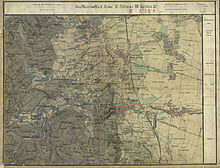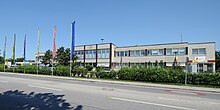Wiener Neudorf
|
market community Wiener Neudorf
|
||
|---|---|---|
| coat of arms | Austria map | |
|
|
||
| Basic data | ||
| Country: | Austria | |
| State : | Lower Austria | |
| Political District : | Mödling | |
| License plate : | MD | |
| Surface: | 6.04 km² | |
| Coordinates : | 48 ° 5 ' N , 16 ° 19' E | |
| Height : | 205 m above sea level A. | |
| Residents : | 9,354 (January 1, 2020) | |
| Population density : | 1549 inhabitants per km² | |
| Postcodes : | 2351, 2355 | |
| Area code : | 0 22 36 | |
| Community code : | 3 17 25 | |
| NUTS region | AT127 | |
| Address of the municipal administration: |
Europaplatz 2 2351 Wiener Neudorf |
|
| Website: | ||
| politics | ||
| Mayor : | Herbert Janschka ( ÖVP ) | |
|
Municipal Council : ( 2020 ) (33 members) |
||
| Location of Wiener Neudorf in the Mödling district | ||
| Source: Municipal data from Statistics Austria | ||
Wiener Neudorf is a market town with 9354 inhabitants (as of January 1, 2020) east of the district capital Mödling in the industrial quarter in Lower Austria near Vienna .
geography
Wiener Neudorf is located in the flat part of the Mödling district , in the Vienna Basin .
Community structure
The municipality includes only one place, and one cadastral municipality and locality . Districts are the industrial center of Lower Austria-South and the Mitterfeld settlement .
Neighboring communities
|
|
Vösendorf |
|
| Mödling |

|
Biedermannsdorf |
| Guntramsdorf |
Wiener Neudorf does not border on Laxenburg: In the industrial center of Lower Austria South there is an approx. 150 m long border section on which Biedermannsdorf borders on Guntramsdorf and thus separates Wiener Neudorf from Laxenburg.
history

The first settlement of the Mödling area (and thus Wiener Neudorf included) can be dated to around 4000 BC, which is mainly concluded from finds of vessels.
Wiener Neudorf was first mentioned in the middle of the 12th century (Nowendorf) . In exchange for the village of Siegenfeld (it was donated to the Heiligenkreuz monastery ), Duke Heinrich II. Jasomirgott received, among other things, a hat (a courtyard with 10-15 hectares of land) at Nuwendorf around 1176 . In a document of the Klosterneuburg monastery from 1231, a judge (= mayor) Meinhard von Neudorf ( Meinhardo iudice de Niwedorf ) is named as a witness. Wiener Neudorf's existence can be considered certain from 1270 at the latest: A document from that year lists the tolls of Sollenau and Wiener Neudorf - the toll station at the Mödlingbachbrücke would be closely linked to the development of the area well into the 19th century.
In the middle of the 14th century, crop failures (1330s and 1340s) and the outbreak of the plague caused the area to decline in population. In 1500 there were around a fortified complex in the village, the parties Neudorf. (This was destroyed by invading Turks at least once).
It was primarily the postal system of the early 19th century that helped Wiener Neudorf get its current name. In order to better distinguish the many places with the same name, these were given additions to names - such as 'Neudorf bei Staatz' or 'Neudorf bei Pöggstall'. Wiener Neudorf was simply a 'W.' placed in front of the name. This spelling became more and more popular until it was officially recognized in 1854. On the official map, however, the place was still listed as Neudorf (near Vienna) in the 1870s .
Industrialization also began in the Wiener Neudorf area in the middle of the 19th century . Above all, the abundant raw material for bricks offered a favorable location for the Wienerberger company’s Neudorf brickworks , and many clay pits were not only built in Wiener Neudorf. Four of the brick ponds that were created on Vienna's Neudorfer Boden at the time , as the clay marl excavation pits are called, are still preserved today: The community pond , formerly Kahrteich , named after the neighboring general store Kahr , the Erikateich on the Isovolta company premises and the Blue Lagoon , originally the blue pond and the most popular pond for swimming at the time, the Schinterteich (also Schinderteich ) located in the area of Maria Enzersdorf today . Also worth mentioning during this time is the Austria brewery , which at that time was one of the largest breweries in the country.
A lot happened in the village around 1900: the local telephone network was standardized with that of the neighboring communities. The place got its own gendarmerie post and the sewer system was expanded.
After the Anschluss , Wiener Neudorf was incorporated into Greater Vienna in 1938 as part of the 24th district - a situation that lasted beyond the end of Greater Germany . It was not until 1954 that Wiener Neudorf became an independent municipality again.
During the Second World War , the Wiener Neudorf satellite camp existed , a sub-camp of the Mauthausen concentration camp . Preparatory work for the Ostmark aircraft engine works began around 1940 . Even before these were completely expanded, the first Allied bombing raids in the area began in 1943. Despite the local aero engine factories, there were relatively few deaths from bombing raids. A heavy attack on the Ostmarkwerke took place on July 26, 1944, which hit the camp of the concentration camp prisoners deployed there in addition to the damage on the premises. 31 of them were killed. Since their accommodations were also destroyed, the surviving prisoners had to be moved to a new camp in the municipality of Wiener Neudorf (Mitterfeld) the next day. But the attacking American bombers also suffered heavy losses. A bomber unit of 26 aircraft, for example, shot down eight machines in Styria and three in Lower Austria within a few minutes, with 66 crew members dying and 43 others being captured.
By the end of the war in 1945, around 80% of the houses were damaged; around 30 were completely destroyed or uninhabitable. The place came under Russian control on April 6th. Theo Rossiwall writes in his book The Last Days about the fighting in Wr. Neudorf (April 8, 1945): "Wiener Neudorf had three days of fighting with firebombs behind them, a bridge on the Badnerbahn was destroyed."
Population development
| census | Residents |
|---|---|
| 2011 | 8,838 |
| 2001 | 8,428 |
| 1991 | 8,385 |
| 1981 | 7,933 |
| 1971 | 4,072 |
Source: population development of Wiener Neudorf. (PDF) Statistics Austria
politics
Community representation
- Mayor : Herbert Janschka, ÖVP
- Municipal council (33 seats) : 17 ÖVP , 11 SPÖ , 2 Umweltforum Wiener Neudorf, 2 FPÖ , 1 NEOS
Partnerships
Wiener Neudorf's partner municipality has been Bärnkopf in the Waldviertel since 1973 .
Economy and Infrastructure
On the site of the former Flugmotorenwerke Ostmark , which later became the USIA company , Eco Plus built a large industrial site, most of which belongs to the municipality of Wiener Neudorf. Thanks to the good transport connections, a large number of companies that moved out of the metropolitan area of Vienna settled in (industrial center south). As a result, Wiener Neudorf is now one of the economically strongest communities in Austria. Part of the Shopping City Süd is in Wiener Neudorf and the industrial center Niederösterreich Süd (IZ NÖ Süd) with companies such as LKW Walter , BILLA , Isovolta , Eternit-Werke , Hitachi and Konica Minolta is largely located on Wiener Neudorf.
The Eco Plus industrial site and the center of Wiener Neudorf are supplied with biomass district heating from the Mödling district heating network .
From 1982 to mid-2014, the Palmers headquarters were in Wiener Neudorf, Palmersstrasse 6–8. The glazed cuboid building erected there (office tower, owner since 2007: Immobiliengruppe Tecto, Vienna) is a striking landmark 450 m to the right when driving on the A2 at km 7 in the southeast direction. The contour of its N – NNE-oriented facade last shone in Palmers green for years. Then used as an outlet by Palmers.
traffic
By motorway A2 and the local train , it is in a short time from the federal capital Vienna to achieve. The S1 expressway , which was completed in 2006, and Mödlinger Straße B 11 lead into the Schwechat area .
But the west is also easily accessible via the Vienna outer ring motorway.
Culture and sights
buildings
- Old Town Hall
- Parish church Maria Schnee with rectory and war memorial
- Monastery church with frescoes by Maria Loretto Kastner
- Marian column
- Turkish cross
- Prenninger Chapel
- Hackl cross
- Christoph Migazzi House
Personalities
Important people who were born here or who worked here:
- Carl Prenninger (1829–1902), civil engineer, railway specialist, honorary citizen of Wiener Neudorf
- Robert Herzfelder (1841–1907), industrialist, ran the Austria Brewery and from 1881 to 1900 also the brick works on Griesfeld in Wiener Neudorf. He was a member of the municipal council of Wiener Neudorf and was made an honorary citizen of Wiener Neudorf in 1897.
- Alois Pennarini (1870–1927), opera singer (tenor), theater director and silent film actor
- Othmar Skala (1895–1958), Lower Austrian homeland researcher
- Anton Pürkner (1909–1991), musician, composer
- Franz Fürst (1920–2005), member of the state parliament, mayor of Wiener Neudorf 1955–1990.
literature
- Kurt Janetschek: Wiener Neudorf through the ages . 1978
- Our Neudorf magazine . Communication from the archive of the market community Wiener Neudorf (since 2000)
Web links
- Community website
- Entry on Wiener Neudorf in the Austria Forum (in the AEIOU Austria Lexicon )
- 31725 - Wiener Neudorf. Community data, Statistics Austria .
Individual evidence
- ↑ a b Franzisco-Josephinische Landesaufnahme , record sheet 4756 / 4b Mödling, Perchtoldsdorf , around 1872.
- ↑ Stiftsarchiv Heiligenkreuz: Document: Heiligenkreuz, documents (~ 1133-1775) 1176 (document around 1176) in the European document archive Monasterium.net .
- ↑ Stiftsarchiv Klosterneuburg: Document (document from 1231) in the European document archive Monasterium.net .
- ↑ Wiener Neudorf - Flugmotorenwerke Ostmark ( Memento of the original from March 6, 2010 in the Internet Archive ) Info: The archive link was inserted automatically and has not yet been checked. Please check the original and archive link according to the instructions and then remove this notice. , Website www.geheimprojekte.at, accessed on December 27, 2014
- ^ History of the Wiener Neudorf subcamp ( Memento from December 26, 2014 in the Internet Archive ), website www.mauthausen-memorial.at
- ^ Major attack by the 15th US Air Force on Eastern Austria on July 26, 1944 - overview of the losses of the 301st bomber group , website regiowiki.at, accessed on December 26, 2014
- ↑ Results of the municipal council election 2020 in Wiener Neudorf. Office of the Lower Austrian State Government, January 26, 2020, accessed on January 26, 2020 .
- ↑ http://noe.orf.at/news/stories/2641834/ Palmers relocates headquarters to Vienna, orf.at April 14, 2014, accessed October 4, 2015.
- ↑ http://www.noen.at/nachrichten/lokales/aktuell/moedling/Palmers-zieh-aus;art2664,529533 Palmers moves out, noen.at, April 16, 2014, accessed October 4, 2015.
- ^ Austria-Brauerei im RegiowikiAT accessed on July 25, 2014
- ↑ [1]







